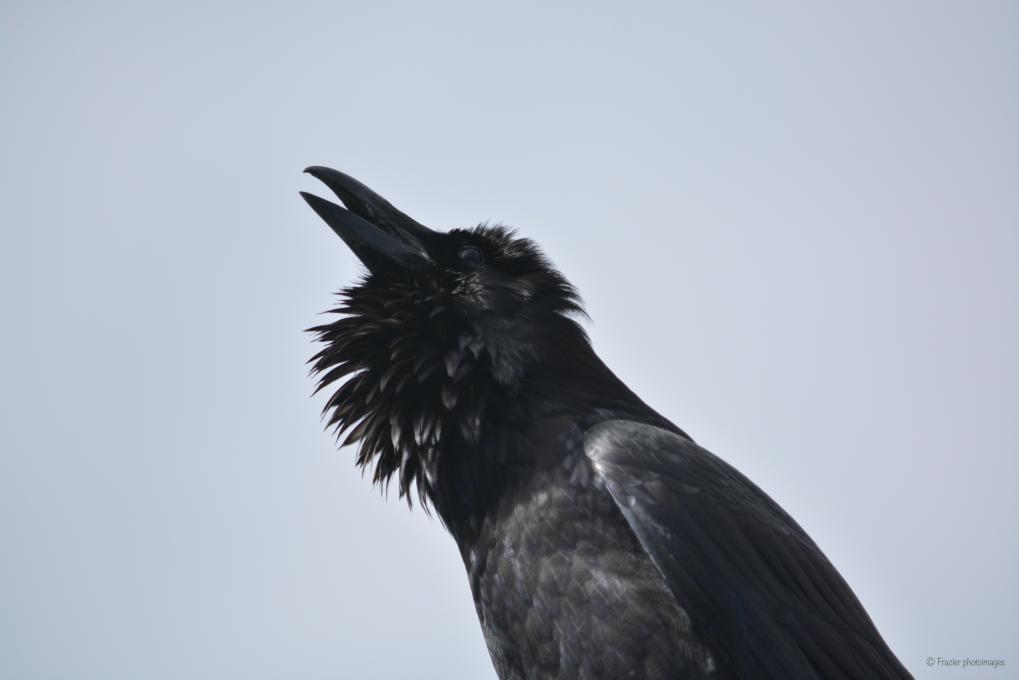The Cornell Lab Bird Academy › Discussion Groups › Anything but Common: The Hidden Life of the American Crow › What is a Crow?
-
Bird AcademyBird Academy
- Your neighbor is complaining about the American Crows killing all the songbird nestlings. What would you say to him/her?
- Where have you seen American Crows? Based on what you learned in this lesson, see if you can locate a crow’s nest (keeping a respectful distance) and share what you found.
- You’ve seen the range map for the American Crow. Here is the range map for Common Ravens.
 Do you live where there are both species? If so, can you now distinguish between them? What differences have you noticed in their behavior?
Do you live where there are both species? If so, can you now distinguish between them? What differences have you noticed in their behavior? - What birds and other animals might benefit from having crows around? Why? How?
You must be enrolled in the course to reply to this topic. -
1.I would suggest to the neighbor that human interference with native bird populations should truly be a last resort. If they are finding that songbirds are at a loss of suitable habitat and are being over-predated due to this, local conservation or restoration of the birds' habitat would be a great place to start. 2. I have seen Crows in various places across the US, they are welcome neighbors from Michigan to Washington. In the southeastern US I have seen more Fish Crows than American Crows. 3. I do not live near Ravens' habitat but I am always shocked by their large size when I travel into their range. 4. Crows are vital to the plants and animals across their habitat. Their caching behavior ensures a large spread of seedlings like Oaks, whose seeds otherwise do not travel far. Other birds may rely on the safety in numbers of Crows. Their large family size means there are more eyes (and noise) to alert surrounding species to predators and other danger. Crows are frequently seen hazing hawks and other raptors which momentarily allows for smaller animals to escape to safety. They are a keystone species that helps maintain equilibrium to their habitat.
-
1. I would tell them that there are many other, more proficient, baby bird killers and that in all honesty it is simply nature 3. I live on the edge of the ravens range, if I travel about 2 hours north they are common, however we do get them down this way on occasion and there are a few known populations of them in the area. 4. When I first got chickens I was told that if you invite the crows to hang around you'll have less hawk predation on your free range chickens, I have seen this to be true. The crows often times chase the hawks out of the area.
-

-
1. Yes, crows will kill and feed songbird nestlings to their young if given the opportunity, but squirrel/chipmunk and snake populations are bigger threats. 2. I live in Nova Scotia, Canada where we see crows all the time. We are fortunate to watch nesting activities almost each spring (20 years off and on) as there is a nest in a large tree in our neighbour’s yard. The crows are extremely quiet throughout the nesting period but that all changes when the babies fledge. We’ve often loaned umbrellas to people walking down our street to protect them from being “bombed” by crow parents and aunties! 3. I live in an area where both crows and ravens live, although ravens are rare. Crows often surround and harass single ravens, cawing loudly. Recently however, in the late fall early winter, I saw a group of 4 or 5 ravens (unusual), take turns pulling apart the crow’s nest in our neighbour’s tree while the others excitedly ronked on encouraging the behaviour it seemed. The crows were not impressed. I’m waiting to see if they rebuild their nest or if the ravens will take over. 4. Crows can provide nesting sites for large birds. They also distribute seeds from helpful plants.
-
1. In reality, crows are very low on the list of animals predating on songbird nests. Squirrels and chipmunks are much more of a threat to the nests. 2.
-
I really like and appreciate crows, as I do all native birds. This lesson addressed the myth that crows eat an outsized number of baby birds compared to other predators. While it's good to dispel such myths and learn the facts, I did want to mention something I recently learned, which is that the success of "subsidized" corvids (crows and ravens that benefit from being around humans) is causing hyperpredation of turtles and tortoises (see Hyperpredation of Freshwater Turtles and Tortoises by Subsidized Corvids | Herpetological Monographs (allenpress.com)). Those of us taking this course obviously love birds, but if you don't know much about turtles, they have it really rough! Reasons include that because they move slowly, they're easily killed by many things (natural predators, cars, humans), 70% of illegal wildlife trade is in reptiles and amphibians, and turtles take a very long time to reach sexual maturity (something like 4-20 years, depending on species). They are very vulnerable animals. I thought this was just interesting to know, but also a good reminder that it's generally best for humans not to interfere in natural processes by "subsidizing" certain species, since we don't fully understand the downstream impacts on other creatures in the ecosystem (and yes, I understand our activities do more damage than any other species!). The best way to support animals is by creating rich habitat (if you have space to do so) with native plants that provide food, cover, and sites to rest, reproduce and nest, which benefits all animals. I'm not being preachy if you choose to feed birds, just encouraging folks to support all animals if possible, which allows nature to better do its job of keeping things in balance :).
-
1. You may think that crows kill most of the nestling birds, but a study shows that squirrels and snakes are the murderer for more than half of the killed nestlings, while crows only kill a fraction. Additionally, crows eat and kill so they can survive, and us as humans also kill and eat baby animals such as lambs. 3.I do live somewhere where crows and Ravens are both present, though Ravens are rarer. While standing, Ravens are larger and they have shiny throat feathers, while crows are smaller and dull in comparison; while flying Ravens give a more pointed look with pointed wings, tails, and beak, whereas crows are more rounded. In my opinion, crows and Ravens give a different kind of feeling, crows seem to be a shy observer and a Raven looks bulkier. 4.Plants, raptors and the whole ecosystem benefits from crows. Crows distribute seeds and provided nesting sites for raptors, since crows are not an invasive species, they consume and are been consumed which keeps the ecosystem in balance.
-
1. Oh no snakes and squirrels kill them much more than crows do. 2/3. California. In cities they r all crows and in suburban area they r all ravens. I find the size difference the easiest way to tell them apart. But I am amazed how ravens can survive in California hot desert and at the same time alaska. 4. Other birds/squirrels, who can benefit from crows' alarm calls.
-
I live in the suburbs of Philadelphia. We have quite a few crows, but also have fish crows. I have been trying to make friends with them for sometime. I am absolutely enamored by crows. I feed them peanuts every day. However, there is a competition with the Blue Jays. However, the crows are getting more and more accustomed to coming up on our porch.

-
Here in Flagstaff, AZ, we get both crows and ravens. I feel like I'm pretty good at telling them apart, but I think the tail shapes in flight aren't always as different as you may think. I love both kinds of these birds!
-
I am one of those people who would complain about the noisy raucous murders of crows in my neighbourhood - there are way too many crows and not enough song birds! However, I am glad to know that the crows are way down the list of bad guys that eat songbirds! I can now tell others that in fact, they are around 1% of the list of predators. I am on the hunt now for a more prevalent killer of songbirds around me - somebody's cat that is allowed to roam! I was also really surprised to know that chipmunks (and squirrels) eat songbirds. Because there are so many crows in my neighbourhood (I live in London Ontario) I started watching them to see when they move in in the spring, what they do, where they seem to hang out, etc. I happened to see one crow fly to the top of a maple tree only to realize there was a nest way up there with the adult crows flying in and out. Next door to me there is a very tall spruce tree with a nest at the very top that I can't see, but that used to house crows and instead housed a family of merlins this season. Now I know there is a more annoyingly noisy bird than crows! And more dangerous! I actually saw a raven this past summer in a community garden In london ON. It caught my eye because it was huge! It also had almost a rusty bark sound rather than the caw of the crow. Apparently the raven has been hanging around that garden this summer. Having learned that the raven looks to be more common north - like Georgian Bay/Lake Huron area - when I go up to my cottage this summer I will look for ravens! It looks to me like the crows are largely the alert system for other birds. When I hear a big raucous carrying-on of crows, I look to see what they've found. Often a big old red-tailed hawk moving in for a look. The hawks persist in their alert and fly-bys until they force the hawk out of the area. That, I'm sure offers tremendous relief to birds and squirrels alike! Thanks for all the great information I'm learning!
-
1. my neighbours don't complain a lot about American Crows because I live in Italy and I mainly see hooded crows, carrion crows and ravens in my area 2. I've seen them often in California and in Seattle. I hope to see many of them on my upcoming trip to Canada 3. that map tells me I have good chances of seeing them on my trip! 4. I am not sure which birds would benefit directly from crows. Maybe some smaller birds that are not part of a crow's diet? My local crows seem pretty good at mobbing other predators out of their area, I wonder if the american crows show the same behaviour
-
3. I live in the Blue Ridge Mountains of North Carolina. Some of the tallest mountains in the Appalachian chain are here. We have ravens that inhabit the highest peaks, some more than 5,000 feet elevation. Both species can be seen or heard where I live at 3,600 feet elevation. The crows travel more in groups and the ravens are more solitary. I distinguish the difference between them more by calls or by overflight. The tail feathers are my best method for determining the overflight identification. Attached are a pair of images of ravens I have captured while birding.


-
1) I would say that statistically, squirrels eat eggs/songbirds nesting much more than crows do. 2) I see crows every morning in my neighborhood. They recognize me and start cawing as soon as they see me. I feel so happy when they call me. I have named them, Sheryl and Russell. There are actually four of them that are regular visitors and cawers to me. I've told all my neighbors about Sheryl and Russell and they like them too-- they think I'm hilarious and my husband does too and he's even interested in birds and he never was before. Crows are so interesting. They love the peanuts I put out for them and come over to eat them as soon as I go back in the house. I can't wait to learn more. Thank you for this program. 3) No. Doesn't look like Ravens are in Virginia too much. I would know because Ravens have more pointed tails and beaks and have five fingers instead of four. They also have beautiful black / purple-y feathers. 4) Crows warn other birds that prey is coming, so other smaller birds would appreciate crows.
-
3. i have seen many crows in Ontario Canada, but not many ravens. went i was on a trip to Northern Alberta near a glacier there were ravens in the parking lot at the visitor centre. i was honestly surprised at how big they were. significantly bigger than any crow I've seen. The Ravens, there were 3, were very smart and patient waiting for visitors to drop a piece of food or rummage through the garbage cans. Now that I am back in Ontario, i've noticed many more Ravens. their croaks are distinctive and much different than a crow's caw.
-
1. I would remind them that crows are songbirds themselves (most people don't seem to know they're passerines!) and that other animals like snakes and squirrels are more likely to be nest predators. But I also like snakes and squirrels! Life is messy and there are a lot of niches animals have evolved into. Crows are great generalists. 3. Although that map doesn't show it, ravens have recently moved into my area and are spreading into the eastern US, not just the mountains, where I used to have to travel to see them. It's been wonderful! Last January, a raven was even eating a mouse on top of a telephone poll next to my building! This June I finally found out where the neighborhood ravens live and there are at least four of them, probably a family. Sound is the easiest way to distinguish, but if they're quiet than size, gliding, diamond tails, and large bills are how I recognize the ravens. But where I live, we have tons of Fish Crows and they look very similar to American Crows. They're a bit smaller and sleeker, but it's hard to tell them apart except by voice. Fish crows have a much more nasally caw. Fish Crows seem to be more common in summer and American Crows in winter, probably due to the latter migrating to the city from colder areas.
-
I've seen American crows move from neighbourhood to neighbourhood in large gangs. I'm told they all nest in one particular park in the east of the city (Burnaby, BC, Canada).
-
I used to live in Burnaby. Every morning the crows would take a noisy neighbourhood census, and I was upset when they would decide to do that outside my window. Every evening, I would see them flying over in the tens or hundreds to roost - I think they were travelling to Deer Lake or possibly Burnaby Lake.
-
3. I live in British Columbia where there are both. I find sound to be the best indicator; tail shape when flying or bill shape and size if perched closer. The differences in large "fingers" in the wings from the lesson is good to know (ravens - 4; crows - 5). Ravens tend to soar more, while crows don't. In general, I would say you find ravens more often in higher-elevation habitats and forest, whereas crows are more urban (though certainly, both can be found in places - like the dump!).
-
-
1. I would tell my neighbor squirrels and chipmunks along with the stray cat are worse. 2. There is a nest of crows in my neighbors big tree here in Parma, Ohio. I love to hear them in the morning.
-
1. Statistically, squirrels, snakes, and meso carnivores kill a lot more songbird nestlings. One of the best ways people can help songbirds is by keeping their cats indoors! 2. I've seen them pretty much everywhere! We have a lot in my area. 3. Yes, we have both. I mostly tell them apart by their voices, especially if they're near a lot of trees and I can't see them clearly. Crows are much more social and tend to be in bigger groups than ravens. 4. Lots of small animals benefit from crows mobbing and driving off raptors that would otherwise prey on them. Even my chickens probably benefit from crows driving off the occasional Cooper's hawk.
-
1. There was a complaint recently on our local area’s Facebook page. One even mentioned a crow raiding the hawks nest and killing its babies. I just started the course so I posted the chart in this lesson. PS The red tail hawks around here are at least twice the size of crows. When the crows have a nest, they protect it by diving and squawking relentlessly. 2. “My crows” protect the eucalyptus tree in my back space. The couple have lived there for at least the last 10 years. Each year we watch them build a nest, feed the youngster(s), invite friends over sharing the food and water I leave out for them. They appear to be old now. One (Whitey) had a set of white feathers on his right side and the couple preen each other on my fence and in the tree. I believe he got into a brawl, maybe with another crow couple because there were a few weeks that we had a group visit and it did not appear friendly. There was a lot of diving and squawking toward my crows and lots of feathers one day in our front yard. The couple disappeared for a couple of months coming back in spring but with a grayish feather where the white used to be and his right foot toes were curled fist like. They typically stopped coming for a month or two late winter but this was a much longer vacation. I leave peanuts (unsalted) and dog kibble on my fence, so they can easily fly in to get it and the water. (it’s been close to 100 degrees) they come at specific times. They let me come within about 6 feet of them and hop along the fence if I get closer. Whitey’s name is now Clubfoot. Clubfoot usually comes first while his wife? waits on the roof or in the tree until I turn away from the fence, then she flys in passing overhead…Clubfoot let’s her have first dibs on the food. My feeding started because they would always steal the dog treat I would leave for my dog..they eventually followed us part way on our morning walk. 3.I don’t believe I’ve seen ravens. It may have been ravens that “scared” my crows away last year. They did seem bigger but I did not know how to recognize there physical appearances. 4. I noticed more doves, finches and other smaller birds at our fence and backyard since I started feeding the crows. It seems it right after they leave. They get the crows leftovers.
-
1. What's your evidence? 2. In many places I've lived. Here in downtown Portland, only occasionly are they on view at around twilight - usually in snall groups but sometimes up to 20. 3. Yes - both species but I believe behavior differs and ravens are less visible here. I could be completely wrong 4. Crows are great for cleanup, and amusement fpr humans. Their badgering of raptors is helpful to other birds and prey. I've seen them badger great horned owls, snowy owls, red tails, etc/
-
1. It's unlikely that a crow destroyed the nestlings and eggs, in fact, it is more than likely it was a snake or a squirrel. These creatures are much more likely to attack baby birds int he nest. Even other birds, including Jays, are more likely than crows to harm and eat baby birds. 2 / 3. I do not live in an area populated by crows, but I do live in an area populated by ravens. Honestly, until this lesson I had not considered that I was seeing ravens, I thought they were crows. I did grow up in an area that had crows, but did not have ravens, so I have experienced both!
-
1. If my neighbor was complaining I would first tell them to keep their cats inside then explain how crows are way down on the list for killing songbirds. 2. There are several just a couple blocks from my house and beyond from there, here in SW Utah. I have not seen a nest but there are so many juniper trees around that it would be like finding a needle in a haystack! In the winter time they are joined by the Ravens. It seems to me the American Crows are a little bigger in size than average here. Healthy environment? More natural foods and less human scraps? 3. I have been successful in distinguishing them most of the time but when in flight I get confused. I'm learning that the Ravens seem to hang out in pairs and crows, well, can be murderous! Both are fun to watch, they love to play in the wind, and I have witnessed Ravens doing barrel rolls. 4. Lots of raptors around here are mobbed by the crows which keeps them in line :-) I would think that might benefit smaller song birds from predation by the raptors. The other animal that benefits is humans just for the amusement (or maybe just me).
-
First of all, thank you so much for creating this course. I find the American Crow fascinating and am having fun learning more about them! I love the analogy that they are party animals, as I've observed them engage in behaviors that very much reflect that. 1. I would explain that I was concerned about that too, but I researched it and it's actually not true! I would encourage them to research it themselves via the Cornell Lab website. 2. I have a crow nest in my backyard, hence I want to learn more! It's so high up in our white pine, I haven't seen it without obstruction, but I did get to witness them bringing sticks, twigs and moss up there to build it :) 3. I live only where American Crows are. I've never seen a Common Raven, but would love to! 4. Most songbirds and small mammals living in a backyard would benefit because crows are so good at alarming or mobbing when something is happening, whether it be a hawk soaring above or the neighbors removing a tree (I listened to the alarm sound for a while when that happened.)
Read More:




